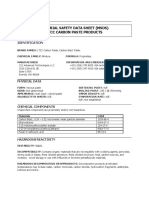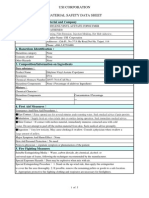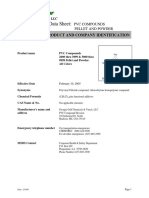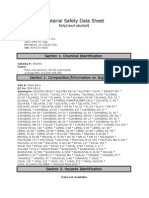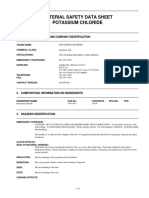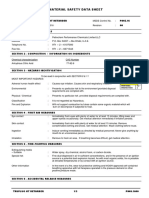Potassium Hydroxide PDF
Potassium Hydroxide PDF
Uploaded by
MartiCopyright:
Available Formats
Potassium Hydroxide PDF
Potassium Hydroxide PDF
Uploaded by
MartiOriginal Title
Copyright
Available Formats
Share this document
Did you find this document useful?
Is this content inappropriate?
Copyright:
Available Formats
Potassium Hydroxide PDF
Potassium Hydroxide PDF
Uploaded by
MartiCopyright:
Available Formats
file: sd2ele-1 page 1 of 4
DIPL.-ING. ERNEST SPIRIG POBOX 1140 HOHLWEG 1 CH-8640 RAPPERSWIL
PHONE: (+41) 55 222 6900 FAX: 55 222 6969 INFO@SPIRIG.COM WWW.SPIRIG.COM
MATERIAL SAFETY DATA SHEET (MSDS)
Potassium Hydroxide Solution
SECTION 1 - CHEMICAL PRODUCT AND COMPANY IDENTIFICATION
MSDS Name: Potassium Hydroxide Solution 40% To 50%
Catalog Numbers: SF/ ELE-1
Synonyms: Electrolyte Fluid for SPIRFLAME
Company Identification: Spirig Ernest, Dipl.Ing., Hohlweg 1, CH-8640 Rapperswil, Switzerland
For information, PHONE: (+41) 55 222 6900 FAX: (+41) 55 222 6969 info@spirig.com
Emergency INFOTRAC : USA +1 352 323 3500
Emergency Number: -
For CHEMTREC assistance, call: -
For International CHEMTREC assistance, call: -
SECTION 2 - COMPOSITION, INFORMATION ON INGREDIENTS
CAS# Chemical Name % EINECS#
1310-58-3 Potassium hydroxide approx. 30 215-181-3
proprietary Additives, various <5 proprietary
7732-18-5 Water Balance 231-791-2
Hazard Symbols: C
Risk Phrases: 35
SECTION 3 - HAZARDS IDENTIFICATION
EMERGENCY OVERVIEW
Appearance: Clear to slightly turbid.
Danger! Causes skin burns. Causes eye burns. Causes digestive tract burns.
Causes respiratory tract burns. Corrosive.
Target Organs: None.
Potential Health Effects
Eye: Causes severe eye burns. May cause irreversible eye injury.
Contact may cause ulceration of the conjunctiva and cornea. Eye
damage may be delayed.
Skin: Causes skin burns. May cause deep, penetrating ulcers of the skin.
Ingestion: May cause circulatory system failure. May cause perforation of the
digestive tract. Causes severe digestive tract burns with abdominal
pain, vomiting, and possible death.
Inhalation: Irritation may lead to chemical pneumonitis and pulmonary edema.
Causes severe irritation of upper respiratory tract with coughing,
burns, breathing difficulty, and possible coma.
Chronic: Prolonged or repeated skin contact may cause dermatitis. Prolonged
or repeated eye contact may cause conjunctivitis.
SECTION 4 - FIRST AID MEASURES
Eyes: Immediately flush eyes with plenty of water for at least 15 minutes,
occasionally lifting the upper and lower lids. Get medical aid immediately.
Skin: Get medical aid immediately. Immediately flush skin with plenty of
soap and water for at least 15 minutes while removing contaminated
clothing and shoes. Discard contaminated clothing in a manner which
limits further exposure.
Ingestion: Do NOT induce vomiting. If victim is conscious and alert, give 2-4 cupfuls of milk or
water.
Never give anything by mouth to an unconscious person.
Get medical aid immediately.
file: sd2ele-1 page 2 of 4
DIPL.-ING. ERNEST SPIRIG POBOX 1140 HOHLWEG 1 CH-8640 RAPPERSWIL
PHONE: (+41) 55 222 6900 FAX: 55 222 6969 INFO@SPIRIG.COM WWW.SPIRIG.COM
Inhalation: Get medical aid immediately. Remove from exposure to fresh air immediately.
If not breathing, give artificial respiration. If breathing is difficult, give oxygen.
Notes to Physician: Treat symptomatically and supportively.
Antidote: None reported.
SECTION 5 - FIRE FIGHTING MEASURES
General Information: Does not apply.
Extinguishing Media: Does not apply.
Autoignition Temperature: Does not apply.
Flash Point: Does not apply.
NFPA Rating: 3-0-1-COR NFPA = USA National Fire Protection
Association Explosion Limits:
Does not apply.
SECTION 6 - ACCIDENTAL RELEASE MEASURES
General Information: Use proper personal protective equipment as indicated in Section 8.
Spills/Leaks: Absorb spill with inert material, (e.g., dry sand or earth), then place into a chemical
waste container. Neutralize spill with a weak acid such as vinegar or acetic acid.
SECTION 7 - HANDLING and STORAGE
Handling: Wash thoroughly after handling. Remove contaminated clothing and wash before
reuse. Use with adequate ventilation. Do not get in eyes, on skin, or on clothing. Do
not ingest or inhale.
Storage: Store in a tightly closed container. Store in a cool, dry, well-ventilated area away
from incompatible substances. Keep away from strong acids.
SECTION 8 - EXPOSURE CONTROLS, PERSONAL PROTECTION
Engineering Controls: Use adequate general or local exhaust ventilation to keep airborne concentrations
below the permissible exposure limits.
Exposure Limits
Chemical Name ACGIH NIOSH OSHA - Final PELs
Potassium hydroxide C 2 mg/m3 none listed none listed
Water none listed none listed none listed
OSHA Vacated PELs:
Potassium hydroxide: C 2 mg/m3
Water: No OSHA Vacated PELs are listed for this chemical.
Personal Protective Equipment
Eyes: Wear appropriate protective eyeglasses or chemical safety goggles as described
by OSHA's eye and face protection regulations in 29 CFR 1910.133.
Skin: Wear appropriate gloves to prevent skin exposure.
Clothing: Wear appropriate protective clothing to prevent skin exposure.
Respirators: Follow the OSHA respirator regulations found in 29CFR 1910.134.
Always use a NIOSH-approved respirator when necessary.
SECTION 9 - PHYSICAL AND CHEMICAL PROPERTIES
Physical State: Liquid
Appearance: clear to slightly turbid
Odor: odorless
pH: 12.0 (0.1 M sol.)
Vapor Pressure: 2.6 mm Hg @ 20 C
Vapor Density: 0.62
Evaporation Rate: Not available.
Viscosity: 3.7 cP
Boiling Point: 271 - 293 F
Freezing/Melting Point: 48 deg F
Decomposition Temperature: Not available.
Solubility: Completely soluble in water
Specific Gravity/Density: 1.51
Molecular Formula: Solution
Molecular Weight: Not available.
file: sd2ele-1 page 3 of 4
DIPL.-ING. ERNEST SPIRIG POBOX 1140 HOHLWEG 1 CH-8640 RAPPERSWIL
PHONE: (+41) 55 222 6900 FAX: 55 222 6969 INFO@SPIRIG.COM WWW.SPIRIG.COM
SECTION 10 - STABILITY AND REACTIVITY
Chemical Stability: Stable.
Conditions to Avoid: Incompatible materials, acids, metals.
Incompatibilities with Other Materials: Not available.
Hazardous DecompProducts: Oxides of potassium.
Hazardous Polymerization: Not available.
SECTION 11 - TOXICOLOGICAL INFORMATION
RTECS#:
CAS# 1310-58-3: TT2100000
CAS# 7732-18-5: ZC0110000
LD50/LC50:
CAS# 7732-18-5: Oral, rat: LD50 = >90 mL/kg.
CAS# 7732-18-5: Oral, rat: LD50 = >90 mL/kg.
Carcinogenicity:
Potassium hydroxide - Not listed by ACGIH, IARC, NIOSH, NTP, or OSHA.
Water - Not listed by ACGIH, IARC, NIOSH, NTP, or OSHA.
Epidemiology: No data available.
Teratogenicity: No information reported.
Reproductive Effects: No data available.
Neurotoxicity: No data available.
Mutagenicity: No data available.
Other Studies: No data available.
SECTION 12 - ECOLOGICAL INFORMATION
Ecotoxicity: Not available.
Environmental Fate: Not available.
Physical/Chemical: Not available.
Other: Not available.
SECTION 13 - DISPOSAL CONSIDERATIONS
EG Disposal Code: 20 01 15
Dispose of in a manner consistent with federal, state, and local regulations.
RCRA D-Series Maximum Concentration of Contaminants: Not listed.
RCRA D-Series Chronic Toxicity Reference Levels: Not listed.
RCRA F-Series: Not listed.
RCRA P-Series: Not listed.
RCRA U-Series: Not listed.
Not listed as a material banned from land disposal according to RCRA.
SECTION 14 - TRANSPORT INFORMATION
US DOT
Shipping Name: POTASSIUM HYDROXIDE, SOLUTION
Hazard Class: 8
UN Number: UN1814
Packing Group: II
IMO No information available.
IATA No information available.
RID/ADR No information available.
Canadian TDG Shipping Name: POTASSIUM HYDROXIDE SOLUTION
Hazard Class: 8(9.2)
UN Number: UN1814
SECTION 15 - REGULATORY INFORMATION
US FEDERAL TSCA CAS# 1310-58-3 is listed on the TSCA inventory.
CAS# 7732-18-5 is listed on the TSCA inventory.
Health & Safety Reporting List
None of the chemicals are on the Health & Safety Reporting List.
Chemical Test Rules
None of the chemicals in this product are under a Chemical Test Rule.
file: sd2ele-1 page 4 of 4
DIPL.-ING. ERNEST SPIRIG POBOX 1140 HOHLWEG 1 CH-8640 RAPPERSWIL
PHONE: (+41) 55 222 6900 FAX: 55 222 6969 INFO@SPIRIG.COM WWW.SPIRIG.COM
Section 12b None of the chemicals are listed under TSCA Section 12b.
TSCA Significant New Use Rule
None of the chemicals in this material have a SNUR under TSCA.
SARA
Section 302 (RQ) final RQ = 1000 pounds (454 kg)
Section 302 (TPQ) None of the chemicals in this product have a TPQ.
SARA Codes CAS # 1310-58-3: acute, reactive.
Section 313 No chemicals are reportable under Section 313.
Clean Air Act: This material does not contain any hazardous air pollutants.
This material does not contain any Class 1 Ozone depletors.
This material does not contain any Class 2 Ozone depletors.
Clean Water Act: CAS# 1310-58-3 is listed as a Hazardous Substance under the CWA.
None of the chemicals in this product are listed as Priority
Pollutants under the CWA. None of the chemicals in this product are listed as Toxic Pollutants under the CWA.
OSHA: None of the chemicals in this product are considered highly hazardous by OSHA.
STATE: Potassium hydroxide can be found on the following state right to know lists: California, New Jersey,
Florida, Pennsylvania, Minnesota, Massachusetts. Not present on state lists from CA, PA, MN, MA, FL, or NJ.
California No Significant Risk Level: None of the chemicals in this product are listed.
European/International Regulations / European Labeling in Accordance with EC Directives
Hazard Symbols: C Corrosive
Risk Phrases: R 22 Harmful if swallowed
R 35 Causes severe burns.
Safety Phrases: S 1/2 Keep locked up and out of reach of children
S 26 In case of contact with eyes, rinse immediately with plenty of
water and seek medical advice.
S 36/37/39 Wear suitable protective clothing, gloves and eye/face protection
S 45 In case of accident or if you feel unwell, seek medical advice immediately
(show the label where possible)
WGK (Water Danger/Protection)
CAS# 1310-58-3: 1
CAS# 7732-18-5:
Canada CAS# 1310-58-3 is listed on Canada's DSL/NDSL List.
CAS# 7732-18-5 is listed on Canada's DSL/NDSL List.
This product has a WHMIS classification of E.
CAS# 1310-58-3 is listed on Canada's Ingredient Disclosure List.
CAS# 7732-18-5 is not listed on Canada's Ingredient Disclosure List.
Exposure Limits CAS# 1310-58-3:.
OEL-AUSTRALIA: TWA 2 mg/m3. OEL-BELGIUM: STEL 2 mg/m3 g/m3. OEL-JAPAN: STEL 2 mg/m3. OEL-THE NETHER-
LANDS: TWA 2 mg/m3 SWITZERLAND: TWA 2 mg/m3. OEL- UNITED KINGDOM: TWA 2 mg/m3; STEL 2 mg/m3. OEL IN
BULGARIA, COLOMBIA, JORDAN, KOREA check ACGIH TLV. OEL IN NEW ZEALAND, SINGAPORE, VIETNAM check
ACGI TLV
SECTION 16 - ADDITIONAL INFORMATION
MSDS Creation Date: 12/12/1995
Review Date: 12/Dec/1997 25/May/1999 May 12, 2000 June 20, 2001 June 20, 2006
Compared with MSDS of leading Chemical Supply houses. No differences found.
Printed: 4.9.2007
The information above is believed to be accurate and represents the best information currently
available to us. However, we make no warranty of merchantability or any other warranty,
express or implied, with respect to such information, and we assume no liability resulting from
its use. Users should make their own investigations to determine the suitability of the informa-
tion for their particular purposes. In no way shall Spirig be liable for any claims, losses, or
damages of any third party or for lost profits or any special, indirect, incidental, consequential or
exemplary damages, howsoever arising, even if Spirig has been advised of the possibility of
such damages.
You might also like
- The Facility Manager's HandbookDocument362 pagesThe Facility Manager's HandbookLuân Châu100% (14)
- SDS US English - CIDEZYME Enzymatic Detergent - 2Document7 pagesSDS US English - CIDEZYME Enzymatic Detergent - 2Manna VittaulyNo ratings yet
- Coa MKPDocument1 pageCoa MKPprathama fidiNo ratings yet
- MSDS Sodium Hydrosulfite 90% Ex GuangdiDocument7 pagesMSDS Sodium Hydrosulfite 90% Ex GuangdidianNo ratings yet
- DMDS Data SheetDocument7 pagesDMDS Data Sheetfarooq798100% (1)
- Corexit 9500 - Material Safety Data Sheet - Is Very Dangerous - Gulf Oil DispersantDocument10 pagesCorexit 9500 - Material Safety Data Sheet - Is Very Dangerous - Gulf Oil DispersantMysticalgod UidetNo ratings yet
- Material Safety Data Sheet Jatropa Curcas DTZ 2009Document6 pagesMaterial Safety Data Sheet Jatropa Curcas DTZ 2009Arshita Wahyuning AtmokoNo ratings yet
- Material Safety Data Sheet (MSDS) LTCC Carbon Paste ProductsDocument4 pagesMaterial Safety Data Sheet (MSDS) LTCC Carbon Paste ProductsUfuk AkkasogluNo ratings yet
- N Spec 120 Cleaner Data SheetDocument11 pagesN Spec 120 Cleaner Data SheetSergio Alejandro Loza EscobarNo ratings yet
- Safety: Data SheetDocument6 pagesSafety: Data SheetIan RidzuanNo ratings yet
- Chemicals Zetag DATA Alcomer 74 L - 0410Document2 pagesChemicals Zetag DATA Alcomer 74 L - 0410PromagEnviro.comNo ratings yet
- B-701 Boysen Permacoat Flat Latex2Document7 pagesB-701 Boysen Permacoat Flat Latex2herismycoNo ratings yet
- Sds Msds 000010 Benz Grind HP 6 2011 05-15 BenzDocument5 pagesSds Msds 000010 Benz Grind HP 6 2011 05-15 BenzeadriesNo ratings yet
- Akzonobel ETHOMEEN C 25Document8 pagesAkzonobel ETHOMEEN C 25Hitendra Nath BarmmaNo ratings yet
- Chrome-Extension Mhjfbmdgcfjbbpaeojofohoefgiehjai IndexDocument7 pagesChrome-Extension Mhjfbmdgcfjbbpaeojofohoefgiehjai Indexjangri10980% (1)
- MSDS CarbomerDocument5 pagesMSDS CarbomerInsaf DaldoulNo ratings yet
- BLUESIL BP 9710 RepelenteDocument3 pagesBLUESIL BP 9710 Repelentehector mauricio paez cantorNo ratings yet
- Safety Data Sheet: A. Product NameDocument10 pagesSafety Data Sheet: A. Product NameSEONJONG PARKNo ratings yet
- Pom MSDS PDFDocument3 pagesPom MSDS PDFebercueNo ratings yet
- Msds BPGDocument9 pagesMsds BPGSwapnil ThakurNo ratings yet
- MSDS UreaDocument4 pagesMSDS UreaSharjeel AhmedNo ratings yet
- Peroxido de Benzoilo 32% - India - 31!03!2022 - MsdsDocument7 pagesPeroxido de Benzoilo 32% - India - 31!03!2022 - MsdsYeison DuránNo ratings yet
- MSDS Linalool PDFDocument7 pagesMSDS Linalool PDFSyafira Indah JulianaNo ratings yet
- Paragan EA MsdsDocument9 pagesParagan EA MsdsU.s. Ezhil ArivudainambiNo ratings yet
- MSDS EVA en UsDocument3 pagesMSDS EVA en UsbangsNo ratings yet
- Potassium HydroxideDocument6 pagesPotassium HydroxideSiti Fatimah NasarNo ratings yet
- PVC MSDSDocument9 pagesPVC MSDSSandry KesumaNo ratings yet
- Safety Data Sheet: Section 1: Identification of The Substance/mixture and of The Company/undertakingDocument6 pagesSafety Data Sheet: Section 1: Identification of The Substance/mixture and of The Company/undertakingmeNo ratings yet
- LigniteDocument6 pagesLigniteArevalo OscarNo ratings yet
- Isononanol: Material Safety Data SheetDocument10 pagesIsononanol: Material Safety Data SheetKayalvilli ShanmugamNo ratings yet
- MSDS Jotun Pilot QDDocument13 pagesMSDS Jotun Pilot QDHaryanto RNo ratings yet
- MSDS Biowish AQUA FOG (STP)Document3 pagesMSDS Biowish AQUA FOG (STP)ijaysquerpantsNo ratings yet
- Nitrogen MsdsDocument2 pagesNitrogen MsdsGangsar LukmanjayaNo ratings yet
- MSDS HEDP - NA4 Granular ENDocument8 pagesMSDS HEDP - NA4 Granular ENPhirate DorindNo ratings yet
- KCC DATASHEET Technical Data Sheet Thinner-024 EngDocument2 pagesKCC DATASHEET Technical Data Sheet Thinner-024 EngIsabelo AbaoNo ratings yet
- Material Safety Data Sheet: PAC - RDocument6 pagesMaterial Safety Data Sheet: PAC - RJose AlejandroBlancoNo ratings yet
- Material Safety Data SheetDocument4 pagesMaterial Safety Data SheetnobelrNo ratings yet
- Ig 55 Material Safety Data SheetDocument4 pagesIg 55 Material Safety Data SheetJason BartramNo ratings yet
- Msds Codex 661 - Rev-01MSDS CODEX 661Document6 pagesMsds Codex 661 - Rev-01MSDS CODEX 661manlekNo ratings yet
- MSDS PC Duron Geo LD 15W-40 PDFDocument7 pagesMSDS PC Duron Geo LD 15W-40 PDFaliosk8799No ratings yet
- Iron Ore, MSDSDocument8 pagesIron Ore, MSDSAlexander ApuraNo ratings yet
- Fluorescein MSDS: Section 1: Chemical Product and Company IdentificationDocument5 pagesFluorescein MSDS: Section 1: Chemical Product and Company IdentificationMaya SeptianaNo ratings yet
- 3DT149Document8 pages3DT149dalton2004100% (1)
- 306Document6 pages306vinithaNo ratings yet
- Msds - Marpozol W-505 (GHS) Eng 130409Document5 pagesMsds - Marpozol W-505 (GHS) Eng 130409Syafarul Mohammad100% (1)
- Clariant SDS NIPAGIN M Indonesia EnglishDocument16 pagesClariant SDS NIPAGIN M Indonesia EnglishSetia BudiNo ratings yet
- Msds Kloroform - 2Document6 pagesMsds Kloroform - 2bayueriyantoNo ratings yet
- SafetyDataSheet (SDS) 31 Liquid en 03122020Document14 pagesSafetyDataSheet (SDS) 31 Liquid en 03122020Harry VandermeerNo ratings yet
- Engine Water Treatment25 LTR (9108)Document2 pagesEngine Water Treatment25 LTR (9108)A.S.M Jahidul IslamNo ratings yet
- Ammonium OxalateDocument5 pagesAmmonium Oxalatedhanaraj39No ratings yet
- Material Safety Data Sheet BiocideDocument11 pagesMaterial Safety Data Sheet BiocideTeguhApriyantoNo ratings yet
- 4b. Baker Hughes SUBSEA 136 SDSDocument10 pages4b. Baker Hughes SUBSEA 136 SDSwahab aliNo ratings yet
- Technical Data SheetDocument2 pagesTechnical Data SheetSCHOPENHAUERNo ratings yet
- Sodium Metabisulfite MsdsDocument6 pagesSodium Metabisulfite MsdsMas CamachoNo ratings yet
- PDS Pat-Add Da 603Document2 pagesPDS Pat-Add Da 603Rahul TadeNo ratings yet
- Enzym Med - MSDSDocument9 pagesEnzym Med - MSDSPan SoapNo ratings yet
- Msds Mineral Transformer OilDocument5 pagesMsds Mineral Transformer OilkhaiNo ratings yet
- Technical Specification: Product Name: Eltesol SC 40/sodium Cumene SulphonateDocument1 pageTechnical Specification: Product Name: Eltesol SC 40/sodium Cumene SulphonateMOGES ABERANo ratings yet
- Material Safety Data Sheet PVADocument4 pagesMaterial Safety Data Sheet PVARatna SariNo ratings yet
- Hydrochloric Acid MSDSDocument6 pagesHydrochloric Acid MSDSanurag6866No ratings yet
- MSDS Potassium ChlorideDocument6 pagesMSDS Potassium ChlorideokiNo ratings yet
- 845.1600 Truplug HT Retarder (MSDS)Document3 pages845.1600 Truplug HT Retarder (MSDS)U.s. Ezhil ArivudainambiNo ratings yet
- Lime MSDSDocument6 pagesLime MSDSkhurramNo ratings yet
- Iodine Tincture MSDSDocument3 pagesIodine Tincture MSDStophunter0% (1)
- MSDS SnaDocument4 pagesMSDS Snaमनमोहन उइकेNo ratings yet
- Safety Data Sheet: 1. IdentificationDocument7 pagesSafety Data Sheet: 1. IdentificationАлина ВладиславовнаNo ratings yet
- Safety Data Sheet: 1. Product and Company IdentificationDocument7 pagesSafety Data Sheet: 1. Product and Company Identificationmohamed AdelNo ratings yet
- Mistolin AromatizanteDocument8 pagesMistolin AromatizantekatherineNo ratings yet
- Safety Data Sheet: 1. Identification of The Substance/Preparation and of The Company/UndertakingDocument10 pagesSafety Data Sheet: 1. Identification of The Substance/Preparation and of The Company/Undertakingmohamed hamedNo ratings yet
- SDS Bonderitel Ca696 Enus Iss150121Document6 pagesSDS Bonderitel Ca696 Enus Iss150121roariza75No ratings yet
- Platinum MsdsDocument5 pagesPlatinum Msdscoyne_scribdNo ratings yet
- Safety Data Sheet: Resolv Soft BaitDocument1 pageSafety Data Sheet: Resolv Soft BaitJames SmithNo ratings yet
- Cleantrol F Citrus MSDSDocument6 pagesCleantrol F Citrus MSDSVishnu NNo ratings yet
- HCLDocument7 pagesHCLAsif RazaNo ratings yet
- Master All Purpose CementDocument14 pagesMaster All Purpose CementFadel KNo ratings yet
- RG12220FP 12V 22ah MSDSDocument11 pagesRG12220FP 12V 22ah MSDSmartinNo ratings yet
- Product® XXX Sitren Airvoid® 325: Product Specification Technical InformationDocument1 pageProduct® XXX Sitren Airvoid® 325: Product Specification Technical InformationJuanCamiloLemaZambranoNo ratings yet
- Elastosil 401 60 MSDSDocument8 pagesElastosil 401 60 MSDSQuality ControlNo ratings yet
- Hydrax H910 SDSDocument4 pagesHydrax H910 SDSMichael KesslerNo ratings yet
- Petrothene GA635962Document13 pagesPetrothene GA635962Michelle Kozmik JirakNo ratings yet
- READY BIODEGRADABILITY OECD 301F Manometric Respirometry Test Biodeg - Light Hydrocracked Gas OilDocument50 pagesREADY BIODEGRADABILITY OECD 301F Manometric Respirometry Test Biodeg - Light Hydrocracked Gas OilDena MilanyNo ratings yet
- PetersonBrazingFlux MsdsDocument2 pagesPetersonBrazingFlux MsdssalcabesNo ratings yet
- Material Safety Data Sheet: 1. Identification of The Substance/Preparation and The Company/UndertakingDocument4 pagesMaterial Safety Data Sheet: 1. Identification of The Substance/Preparation and The Company/Undertakingramdhani126No ratings yet
- Triethylamine: Safety Data SheetDocument14 pagesTriethylamine: Safety Data SheetIrelena RomeroNo ratings yet
- Potassium Borohydride 500gDocument8 pagesPotassium Borohydride 500galchemy090909No ratings yet
- Safety Data Sheet: AcetoneDocument4 pagesSafety Data Sheet: AcetoneBuwanah SelvaarajNo ratings yet
- VNHL2402002972HG Y24q1Document5 pagesVNHL2402002972HG Y24q1Cao Thắng NguyễnNo ratings yet
- Sulfuric Acid, 96% W/W: Safety Data SheetDocument8 pagesSulfuric Acid, 96% W/W: Safety Data SheetLindi PraditaNo ratings yet
- Safety Data Sheet: 1. IdentificationDocument8 pagesSafety Data Sheet: 1. Identificationdaniel ruizNo ratings yet
- Msds WaterDocument5 pagesMsds WaterSatria Muliya PutraNo ratings yet







